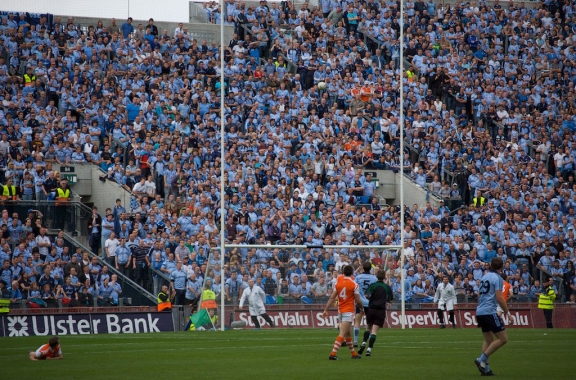
Irish rugby and hurling players compete for their country with no compensation. Jonathan Grimes/Flickr
By Samuel Joseph
DUBLIN — A few weeks ago, I went to my first hurling match at Croke Park in Dublin, Ireland. I had no prior knowledge about either the teams or the venue, nor did I actually know how hurling was played. A friend had found tickets online, and we decided to experience this new sport.
When we arrived, we found ourselves in a stadium that could fit up to 82,000 fans. It was nowhere close to being full, since it was very early in the hurling season. The 12,000 people who were there were dressed fully in blue and white for Dublin, and all the kids inside were waving their team’s flag. This number may not seem so monumental when compared to an average day at Yankee Stadium or MetLife Stadium, but wnot a single player on the hurling field is paid.
The Gaelic Athletic Association (GAA) is both an amateur league and the largest sports organization in Ireland. The GAA is responsible for hurling and Gaelic football as well as many other Irish games.
While working with the Gaelic Players Association, the GAA promotes Irish sports both on a national and county level. The players do not make any money from their teams and, while high-ranked players may have sponsorships to support them, the league is set up to promote players to work other jobs to make their actual money. The players reach a level of professionalism in their sport without the capitalistic trap that leads to drug use and other pitfalls, and the money from tickets which sell for about €15-20, and merchandise is used to pay officials and maintain local clubs for kids and anyone who wants to play.
Like soccer, hurling and Gaelic football are split into two halves. During the 15 minute halftime break, young kids take the field and play the same sport as their elders, with each game moderated by a referee, sometimes one that is the same age as those playing. As a club, the GAA is also in charge of children’s leagues and promoting Irish sports in schools. The GAA is teaching these children that playing is not for some external goal, but rather the purpose of playing is to celebrate Irish tradition and games.
We tried to keep up with the action, watching players bounce a small ball off a stick, dubbed a hurley, back and forth down the pitch. Hurling is like a mixture of ultimate frisbee and American football. The point of the game is to move the ball down the pitch to the net. The net is like a soccer goal, also with a goalie, but has posts rising from each side, like an American football goalpost. If the player hits the ball between the upper posts, his team receives one point. If he can get the ball past the goalie and score in the lower section, he receives a goal, which is worth three points.
While these sports are played by amateurs, the players themselves are not weak. Gaelic football and hurling are all played with no padding and if two players collide and one ends up with a broken nose or takes a hard hit to the head, there is no stoppage of play to help out. Players who are injured are treated on the field by coaches or trainers or are taken off while the game continues. Coaches run over to the goalie or players to advise what to do next while play continue.
Seeing this level of artistry and passion makes me question the United States’ professional sports teams. We are so used to seeing top athletes make hundreds of millions of dollars a year, and it takes away from the true meaning of the game.
As a Yankees fan, I am often criticized for cheering for money. While this complaint is irrelevant to other baseball fans, it sticks when looking at the Irish system. Sitting in Croke Park and watching seven-year-olds take the field, waving hurleys in the air where professionals were just playing is extremely refreshing to see. That level of dedication for a sport is engrossing.
The atmosphere during matches feels close to home and draws the audience in, knowing the passion that fuels each player to play is not that of profit, but actual enjoyment of his sport. Each player represents the place he is from and no matter how small his paycheck, he has his county cheering him on.

Fantastic article! Truly interesting.